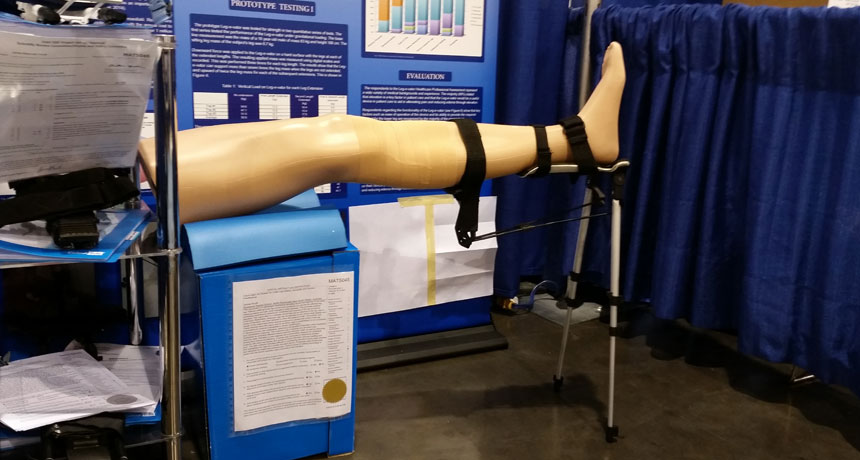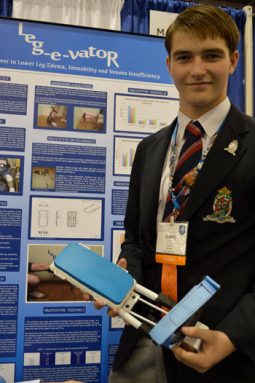Injured leg? Here’s a built-in footstool
New strap-on device helps people elevate an injured leg whenever — and wherever — they need to

A strap-on brace (lower right) was inspired by a golf bag’s kickstand. It can serve as a footstool for people who need to elevate a leg due to pain or disease.
S. Perkins
By Sid Perkins
PHOENIX, Ariz. — Ouch! Let’s say you sprain an ankle or break a bone in your foot. Your doctor will likely advise keeping the affected leg elevated as much as possible. But that could be a problem if you don’t own a recliner or footstool. And if you spend a lot of time on the go, you could end up in plenty of places where keeping your foot up isn’t convenient. So what can you do? An Australian teen may have just the solution.
He showcased his so-called Leg-e-vator, here, this week at the Intel International Science and Engineering Fair. Created by Society for Science & the Public and sponsored by Intel, this year’s competition brought together more than 1,600 students from over 70 countries. (SSP also publishes Science News for Students.)

But James had a brainstorm when he saw the kickstand on a bag that holds golf clubs. Its two-legged brace usually remains folded up against the bag — until a golfer stops to select a club. Then the player deploys the kickstand to form a stable tripod that helps keep the bag from falling over.
How about designing a similar kickstand to elevate a leg, James wondered. Designing, building and refining such a device took the teen several months. That was too long to help his brother, but not too long for the project to qualify for a local science fair.
James’ Leg-e-vator resembles the golf-bag brace, but with a couple of nifty changes. For instance, the teen’s version can be firmly attached to a patient’s leg with adjustable straps. Or, it can be permanently built into a cast or brace that can be taken on and off as needed. Plus, each of the Leg-e-vator’s two “legs” is adjustable. That means the device can be used while sitting in a chair of almost any height.
Finally, just like the golf bag’s kickstand, the Leg-e-vator’s brace can be folded up against the leg when the patients want to walk. Once they reach their destination, voila! Users can flip the brace out — and instant footstool!
The Leg-e-vator might be useful in any number of situations. Many medical problems might lead your doctor to suggest elevating a leg. For example, some people may have poor circulation, making it hard for blood in the leg to efficiently return to the heart. Others may have diseases that cause a buildup of fluid in their ankles and feet. (That symptom is called edema.) Whatever the ailment, studies show that elevating an afflicted limb often reduces swelling and pain, James says.
It might even help young athletes, such as basketball players, who get injured during a game. “They often wish to return to the bench to cheer their teammates,” says James. “Team doctors really hate that, because the athletes should have their foot elevated,” he notes. But with a Leg-e-vator on hand, he says injured players can cheer on their teammates while keeping their foot propped up.
Power Words
(for more about Power Words, click here)
edema Swelling caused by a build-up of fluid in the body’s tissues, particularly in joints or muscles. Edema can be the result of disease, pregnancy or a side effect of some medication.
Society for Science and the Public (orSSP) A nonprofit organization created in 1921 and based in Washington, D.C. Since its founding, SSP has been not only promoting public engagement in scientific research but also the public understanding of science. It created and continues to run three renowned science competitions: The Intel Science Talent Search (begun in 1942), the Intel International Science and Engineering Fair (initially launched in 1950) and Broadcom MASTERS (created in 2010). SSP also publishes award-winning journalism: in Science News (launched in 1922) and Science News for Students (created in 2003). Those magazines also host a series of blogs (including Eureka! Lab).
sprain Stretching or tearing of ligaments, which are the tough bands that connect bones where they come together at a joint.
symptom A physical or mental indicator generally regarded to be characteristic of a disease. Sometimes a single symptom can be triggered by several diseases.
tripod A three-legged stand for supporting a camera or other device.







